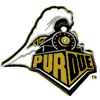|
|
HOME ~ College Football History |
|
Purdue
Mascots
Boilermaker Special
Part of the Purdue scene since 1940, the Boilermaker Special claims to
be the world's largest mascot. Weighing in at 10,800
 pounds, the 24-foot
vehicle is fashioned to look like an old-time locomotive. It is
maintained by the Reamer Club. pounds, the 24-foot
vehicle is fashioned to look like an old-time locomotive. It is
maintained by the Reamer Club.
The current model, Boilermaker Special V, was built by Wabash National
Corp. in Lafayette and unveiled at Purdue's football game with Notre
Dame on Sept. 25, 1993. The task force that redesigned the mascot
consisted of Purdue alumni, local and national business leaders and
students in the Reamer Club.
Efforts to create the first Special began in 1939 with a letter to the
editor of the Purdue student newspaper. The first Special, built with
funds raised by the Reamer Club, operated until 1953. The second Special
was created in mid-1953, the third one was dedicated in October 1960 and
the fourth one is the Boilermaker X-tra Special, a toned-down version
that was christened in 1979.
As a representative of the university wherever it travels, the
Boilermaker Special stands as that tradition of Purdue which is most
familiar to alumni and fans alike. It is a mascot which symbolizes
Purdue's invincibility, immortality and ingenuity.
Boilermaker X-tra Special
The Boilermaker X-tra Special is a toned-down version of the Boilermaker
Special and leads the football team onto the Ross-Ade Stadium field. It
is the first remake of the mini-mascot and is the responsibility of the
Reamer Club. The current X-tra Special was unveiled at Purdue's
homecoming game with Ohio State on Oct. 19, 1996.
Purdue Pete
Purdue Pete begins the 2002-02 season with another busy schedule ahead.
The students who portray the costumed personification of a Boilermaker
make approximately 275 appearances combined each year. They appear at
all home and away football games, home volleyball matches, home men's
and women's basketball games and post-season events. Pete also stops in
on Olympic sport events and makes his rounds to alumni and university
functions, local school fundraisers, visits hospitals and has had
several appearances at weddings!
Songs of Purdue
"HAIL PURDUE"
The Purdue fight song copyrighted in 1913. Music by E. J. Wotowa, class
of 1912; lyrics by J. Morrison, class of 1915.
To your call once more we rally, Alma Mater, hear our praise; Where the
Wabash spreads its valley, Filled with joy our voices raise. From the
skies in swelling echoes Come the cheers that tell the tale Of your
vic'tries and your heroes, Hail Purdue! We sing all hail!
Hail, Hail to Old Purdue! All hail to our old gold and black! Hail, Hail
to Old Purdue! Our friendship may she never lack, Ever grateful, ever
true, Thus we raise our song anew, Of the days we've spent with you All
hail our own Purdue.
When in after years we're turning, Alma Mater, back to you, May our
hearts with love be yearning, For the scenes of old Purdue.
Back among your pathways winding, Let us seek what lies before, Fondest
hopes and aim e'er finding, While we sing of days of yore.
Purdue Spirit
Boilermakers
Boilermakers, the unique nickname of the Purdue athletic teams,
originally was meant as a term of derision and was among several terms
applied to Purdue by Wabash College supporters following a lopsided
(18-4) victory by Purdue in 1889.
Located just 30 miles from Lafayette and bitter athletic rivals of the
day, students of the liberal arts school were inclined to shun the
cultural background of Purdue players who represented a school devoted
to the practical arts of engineering and agriculture.
Boilermakers struck the fancy of the Purdue players, who were also being
called cornfield sailors, blacksmiths, pumpkin shuckers, hayseeds,
farmers and rail splitters.
There also is an unsubstantiated story that Purdue, in the late 1880s,
once enrolled eight boilermakers from the shops of the Monon Railroad
during the football season.
A boilermaker is someone who makes or repairs boilers, a tank in which
water is turned to steam for heating or power, as in a steam engine.
Old Gold and Black
Members of Purdue's first football team in 1887 felt that the squad
should be distinguished by certain colors, and since Princeton was at
the time the most successful gridiron unit, its colors were considered.
Though actually orange and black, the Princeton colors were known by
many as yellow and black. Purdue gridders opted for old gold over
yellow, kept the black, and began flying the colors which endure today.
One later story has it that the black represents mourning for tragedies
costing the lives of Boilermaker gridders on two occasions.
Home Page 
|

 pounds, the 24-foot
vehicle is fashioned to look like an old-time locomotive. It is
maintained by the Reamer Club.
pounds, the 24-foot
vehicle is fashioned to look like an old-time locomotive. It is
maintained by the Reamer Club.